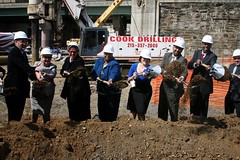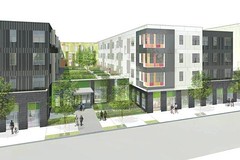City sustainability must begin with reinvestment in neighborhoods

Posted October 15, 2013 at 1:29PM
I’ve written before that, for making our cities and suburbs – where over four-fifths of Americans live – perform better as environmentally responsible people habitat, two geographic scales require our attention. One is the metropolitan region, the scale at which the economy, regional growth and transportation patterns operate. The other is the neighborhood.
Sustainable neighborhoods are the building blocks of sustainable cities. Neighborhoods are where development decisions are made and where increments of change – whether good or bad – actually take place, as well as where residents and workers experience the city environment on an everyday basis. Quite literally, sustainability starts in the neighborhood.
Unfortunately, nothing has been worse for the environmental, economic and social resilience of our people habitat in the last several decades than the decay and disinvestment of our inner-city neighborhoods and accompanying suburban sprawl. Strengthening our existing communities before building new ones is critical to environmental recovery. 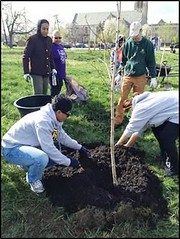 But rebuilding our disinvested city places is not easy, and it can be especially challenging to do so with inclusion and with state-of-the-art green practices, bringing environmental benefits to long-neglected populations.
But rebuilding our disinvested city places is not easy, and it can be especially challenging to do so with inclusion and with state-of-the-art green practices, bringing environmental benefits to long-neglected populations.
A project launched by the organization I work for, the Natural Resources Defense Council, in partnership with community-based organizations has stepped in to provide the ideas and tools that older neighborhoods need to restore their vitality and move toward a more sustainable future. By working directly on the ground with residents, community development corporations, investors, municipalities, and green planning experts, NRDC is employing a collaborative, people-first approach to sustainability, empowering neighbors to restore and revitalize their own communities.
We have worked in five communities so far, and in each we have used a comprehensive evaluation tool that NRDC helped conceive and develop – LEED for Neighborhood Development – to guide our clients in determining their neighborhoods’ environmental strengths and opportunities for improvement. NRDC then works with them on inclusively drawn, tailored sustainability plans to convert opportunities into stronger and healthier futures. We hope each of these communities will then become a model for others to emulate:
- In Indianapolis, NRDC worked with the Mapleton-Fall Creek Development Corporation, the Local Initiatives Support Corporation, and other partners to build local capacity for sustainable practices while building infill development supported by pocket parks.
- In Philadelphia, NRDC assisted the Asociación Puertorriqueños en Marcha, LISC, and the Jonathan Rose Companies in greening a new, transit-oriented, affordable apartment complex Below) that is now the highest-rated green development in the US under LEED-ND.
- In Boston, NRDC worked with the Codman Square Neighborhood Development Corporation, TNT Neighbors United and LISC on plans to convert a 42-acre degraded neighborhood into one of the city’s environmental leaders with deep energy retrofits of its existing building stock, new green buildings, and a redeveloped green street leading to the neighborhood’s new transit station.
- In Los Angeles, NRDC, the Little Tokyo Service Center, LISC, and several additional partners are helping the country’s most important Japanese-American neighborhood – located downtown, three blocks from City Hall at the junction of two major transit lines – protect and enhance its cultural identity while absorbing new development, building more walkable streets, and incorporating new green infrastructure for energy and water management.
- In Ithaca, New York, NRDC helped Agora Development undertake a massive analytical review of all the city’s major planning, transportation, and development guidance so that Ithaca’s policies will become more supportive of green neighborhoods; among the recommendations are focusing development near existing infrastructure; establishing land-use density minimums; removing minimum off-street parking requirements; and providing incentives for green development.
We look forward to work in additional locations. Stay tuned.
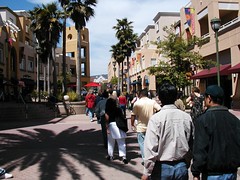 NRDC helped develop LEED-ND, so I may be a bit biased as to its utility in planning. The system isn’t perfect, and obtaining a “green” certification from the US Green Building Council for neighborhood-scaled development requires some precise measurement and not a little time and patience. It is designed to be improved over time, and it can and will be.
NRDC helped develop LEED-ND, so I may be a bit biased as to its utility in planning. The system isn’t perfect, and obtaining a “green” certification from the US Green Building Council for neighborhood-scaled development requires some precise measurement and not a little time and patience. It is designed to be improved over time, and it can and will be.
But we felt from the beginning that the power of the system lay not just in its use for formal certification but also in its application as an informal tool for assessment and planning. LEED-ND is the only tool available nationally to provide a framework for assessing a neighborhood’s strengths and weaknesses in three critical areas: location and linkages to the greater region; the neighborhood’s components and completeness; and its environmental management systems.
These can either be assessed precisely with LEED-ND’s requirements or more informally by thinking subjectively about the subject matter covered by each. The important thing is the categories within the system, each of which has been shown by research and experience to affect environmental performance. We find it to be a particularly useful tool to guide re-investment in older neighborhoods in a way that will enhance those neighborhoods’ environmental performance.
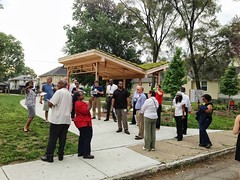 On a related subject, new research conducted by my friend Reid Ewing and a number of colleagues has examined LEED-ND’s relevance to transportation performance and found that, in fact, LEED-ND-eligible development projects may reduce automobile travel (measured as vehicle miles traveled) “from 24 to 60 percent of the respective regional averages” and that “urban projects will receive significant bumps in walking and transit trips,” according to a summary published on the planning web site Planetizen.
On a related subject, new research conducted by my friend Reid Ewing and a number of colleagues has examined LEED-ND’s relevance to transportation performance and found that, in fact, LEED-ND-eligible development projects may reduce automobile travel (measured as vehicle miles traveled) “from 24 to 60 percent of the respective regional averages” and that “urban projects will receive significant bumps in walking and transit trips,” according to a summary published on the planning web site Planetizen.
Ewing et al. suggest that LEED-ND might be simplified by reliance on the various “D” indicators of land use shown by excellent previous research to affect travel behavior, rather than on the measurements currently embedded in the system. (Travel researchers – for better or worse – like to express land use factors by characteristics beginning with the letter D: destination accessibility, distance to transit, diversity of uses, design, and density; the new study adds development scale and demographics.)
That might be true, depending on how complex the necessary measurements would be, if LEED-ND were primarily a tool for reducing automobile dependence. But it isn’t. LEED-ND’s standards – even the ones that relate to vehicle miles traveled – were deliberately chosen to predict multiple outcomes, including land consumption, watershed protection, walkability, human scale, and energy and water management, among many others.  I would argue that the “D” analysis might well suffice – and perhaps even be superior to LEED-ND – for transportation researchers such as the new study’s authors. But the D factors have not been shown to be good indicators of holistic environmental performance.
I would argue that the “D” analysis might well suffice – and perhaps even be superior to LEED-ND – for transportation researchers such as the new study’s authors. But the D factors have not been shown to be good indicators of holistic environmental performance.
Back to NRDC’s work assisting low-income neighborhoods in sustainability planning and investment, our initiative is part of a major commitment that we have made to working on a solutions-oriented approach to the environmental challenges affecting our cities and suburbs. We hope our approach will directly help underserved populations restore disinvested neighborhoods, putting a human face on sustainability; develop and test innovative solutions to place-based problems; build model practices for community development corporations and municipalities to emulate; and help guide the continued implementation and usefulness of LEED-ND.
Related posts:
- How a once-disinvested neighborhood is building community with pride and leadership (written with Matt Higbee) (August 1, 2013)
- How to use LEED-ND to improve an older neighborhood (October 16, 2012)
- Knowing when it's green: A Citizen's Guide to (LEED for) Neighborhood Development (May 25, 2011)
- 5 ways that local groups and citizens can use LEED-ND (January 24, 2011)
- "Cities" may not matter as much as we think - regions and neighborhoods are where things actually happen (November 1, 2010)
- The definitive study of how land use affects travel behavior (June 4, 2010)
Move your cursor over the images for credit information.
.

